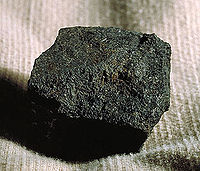
Photo from wikipedia
Abstract The presented paper examines the impact of heating rate on the yield of volatiles and kinetic parameters describing the devolatilization process of sub-bituminous coal. The behaviour of three coals… Click to show full abstract
Abstract The presented paper examines the impact of heating rate on the yield of volatiles and kinetic parameters describing the devolatilization process of sub-bituminous coal. The behaviour of three coals is investigated with the use of two experimental research methods i.e. Thermogravimetric Analysis (TG) and Drop Tube Furnace (DTF). Network models such as FG-DVC and FLASHCHAIN will also used to derived devolatilization kinetics numerically. Results obtained at low and high heating rates, indicate that high heating rates enhance an evolution of the excess yields of volatiles and this effect to some extent can be correlated with the physicochemical properties of the coals under investigation. A robust method of kinetic parameter extrapolation was developed and assessed in terms of its suitability for application to simulate fast pyrolysis. The fraction of released volatiles simulated in drop tube furnace conditions, reveals that extrapolation of TG kinetic data gives results close to these obtained from FG-DVC, while the similarity of DTF and FLASHCHAIN data is more limited. Despite this, eleven out of twelve kinetic datasets fit the experimental trends well.
Journal Title: Journal of Analytical and Applied Pyrolysis
Year Published: 2019
Link to full text (if available)
Share on Social Media: Sign Up to like & get
recommendations!